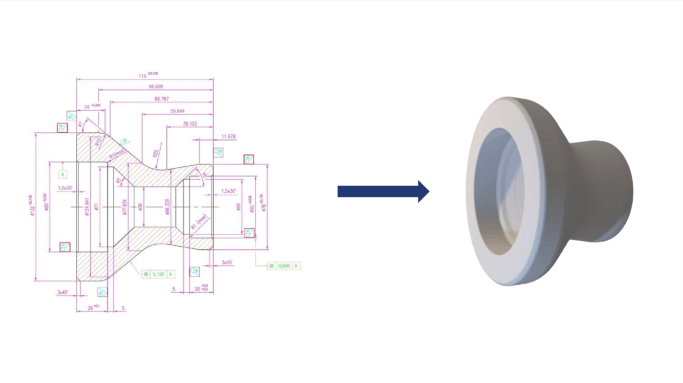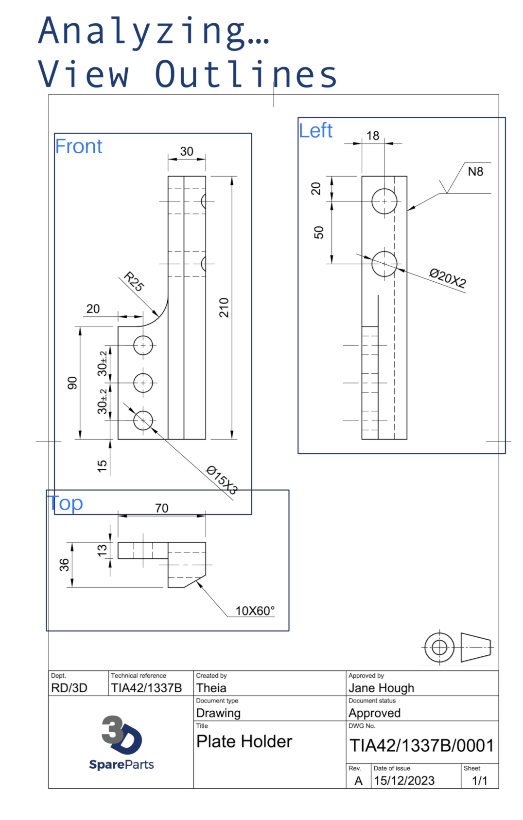French software start-up Spare Parts 3D (SP3D) has launched the beta program of Théia, its new digital tool that can automatically create 3D models from 2D technical drawings.
As global geopolitical and economic factors pose challenges to supply chains, more companies are looking to digitize their inventories, allowing spare parts to be 3D printed locally and on demand. This digitization process, however, can be time-consuming and costly.
Integrating into the company’s AI-driven DigiPart software, SP3D’s new offering leverages deep learning technology to convert existing 2D drawings of spare parts into 3D printable models, reducing conversion times from days to minutes.
The development of the Théia 2D-to-3D printing software was first announced in 2022 through a joint R&D project with the French Defense Innovation Agency (DIA) and the University for Research in Automated Production (LURPA) of the École Normale Supérieure Paris-Saclay.
“Théia addresses two major challenges: on one hand, reading, understanding and interpreting the information present on the drawing, and on the other, obtaining a 3D shape from its representation on 2D plans, while respecting the geometric and dimensional specifications of the original object,” commented Professor Nabil Anwer, Professor at Paris-Saclay University and Deputy Director of LURPA.
SP3D claims that this new tool reduces the cost of digitization. This will allow more companies to leverage additive manufacturing for the production of spare parts, reducing physical inventory costs in the process. In fact, the firm claims that Théia can collectively save companies $34 billion a year through inventory digitization.
SP3D’s DigiPart software
SP3D’s DigiPart software employs artificial intelligence (AI) to identify, digitize, and 3D print spare parts. The offering is targeted towards firms in a range of sectors looking to build affordable, end-to-end digital spare parts inventories.
Through this software, users can identify and map their parts that are 3D printable. The platform then recommends which materials and 3D printing processes are optimal for each part, connecting the user with a 3D printing service provider for production.
DigiPart has drawn interest from a number of multinational clients such as manufacturing conglomerate Honeywell and assurance and risk management company DNV. Additionally, it was announced in 2020 that Brazilian petrochemical company Braskem had adopted the software to improve its supply chain efficiency and reduce overall spare part spending.

Producing 3D models from 2D drawings
A key obstacle to the adoption of additive manufacturing is access to 3D printable models of industrial equipment and parts. The majority of these parts are only available in the form of 2D technical drawings. Conventionally, these drawings need to be manually processed by an engineer to create a 3D model, a strenuous process that can take up to a day to complete per part.
SP3D’s new Théia software is designed to automate this process with a combination of deep learning, computer vision, and existing semantic recognition of optical character recognition (OCR) capabilities. According to Anwer, this combination allows various semantic layers of a 2D technical drawing to be identified and optimally interpreted for 3D reconstruction.
This offering is said to enable significant reductions in storage costs and the immediate availability of locally 3D printed spare parts. As such, companies can re-shore their supply chains, allowing for faster and more secure access to key components.
Paul Guillaumot, founder and CEO of Spare Parts 3D, calls Théia a “world first” that will allow for large-scale digitization of supply chains in sectors with high spare part demand, such as energy, defense, petrochemicals, railways, shipping and mining. The new software also supports France’s Ministry of Defence innovation policy, helping to maintain the operational condition of its military equipment.
Environmental benefits have also been highlighted as a key draw of this new digitization tool. According to SP3D, the combination of digital catalogs and additive manufacturing can end stock obsolescence and enhance the repairability of parts. This can extend the lifespan of machines, reducing waste in the process.
Moreover, by moving production closer to the point of need, Théia can help to minimize transport-related CO2 emissions. Indeed, at COP 28, UN officials identified the increased digitization of supply chains as key to the decarbonization of industry.
SP3D has launched a call for industrial beta testers to take part in a trial of Théia, with a view to generalizing 3D reconstruction from drawings and parts of any complexity. SP3D also hopes to expedite the creation of parametric files, which will allow the software to automatically modify the models according to the chosen manufacturing processes.

The growth of digital inventories
Over recent years, digital inventories have seen increased adoption thanks to the environmental, economical and supply chain advantages they can offer. German railway firm Deutsche Bahn (DB) possesses one of the largest digital inventories of 3D printable spare parts.
Through a partnership with Berlin-based 3D printing software developer 3YOURMIND, the train manufacturer has developed a ‘digital warehouse’ of parts. Leveraging 3YOURMIND’s AMPI software, DB has achieved significant time-savings and reduced vehicle downtime.
Elsewhere, Wibu-Systems offers OMNIplus, an online 3D printable spare part inventory developed in collaboration with German bus manufacturer Daimler Buses and metal 3D printer manufacturer Farsoon Technologies. This online store allows owners and operators of Daimler and Setra Buses to buy and additively manufacture a vast selection of spare parts and components as they are needed.
Similarly, it was announced last year that global transport company MAN Truck & Bus (MAN) had integrated technology from on-demand 3D printing service Replique to optimize its spare parts production strategy. Through this partnership, MAN is 3D printing parts locally and on-demand using Selective Laser Melting (SLM), removing the need for a physical inventory.
What does the future of 3D printing hold?
What near-term 3D printing trends have been highlighted by industry experts?
Subscribe to the 3D Printing Industry newsletter to keep up to date with the latest 3D printing news.
You can also follow us on Twitter, like our Facebook page, and subscribe to the 3D Printing Industry Youtube channel to access more exclusive content.
Are you interested in working in the additive manufacturing industry? Visit 3D Printing Jobs to view a selection of available roles and kickstart your career.
Featured image shows the reconstruction of a 2D technical drawing into a 3D model. Image via Spare Parts 3D.

